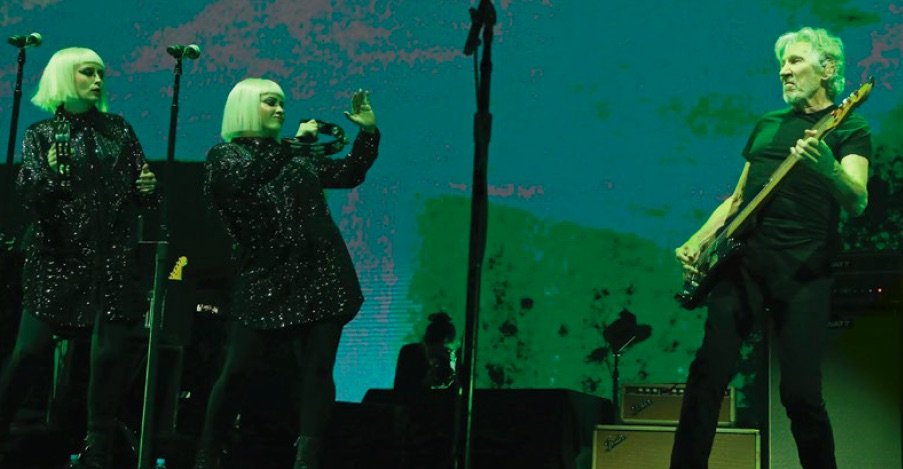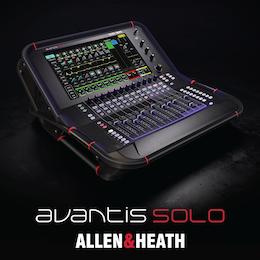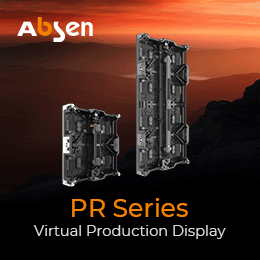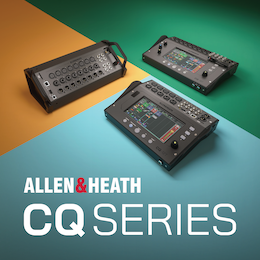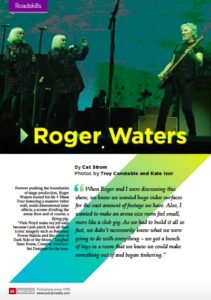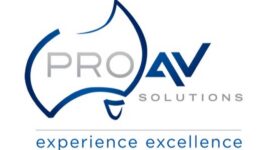Subscribe to CX E-News
ROADSKILLS
Roger Waters
By Cat Strom.
Photos by Troy Constable and Kate Izor.
Forever pushing the boundaries of stage production, Roger Waters toured his Us + Them Tour featuring a massive video wall, multi-dimensional laser effects, a screen dividing the arena floor and of course, a flying pig.
“Pink Floyd make my job easy because I just pinch from all their iconic imagery such as Battersea Power Station and the cover of Dark Side of the Moon,” laughed Sean Evans, Creative Director/Set Designer for the tour.
“When Roger and I were discussing this show, we knew we wanted huge video surfaces for the vast amount of footage we have. Also, I wanted to make an arena size room feel small, more like a club gig. As we had to build it all so fast, we didn’t necessarily know what we were going to do with everything – we got a bunch of toys in a room that we knew we could make something out of and began tinkering.”
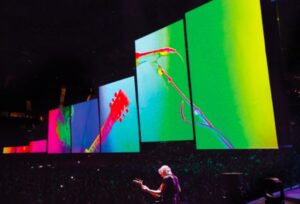 And boy do they have some ‘toys’. The show is all about screens from the expansive screen at the back of the stage to the two modular tracking screens 54 metres long and nearly 11 metres high. In fact the show features over twenty projection surfaces including four inflatable smoke stacks, rolling screens, and the drone-propelled flying pig. Sean supplied all of the video content and animation whilst video director was Richard Turner.
And boy do they have some ‘toys’. The show is all about screens from the expansive screen at the back of the stage to the two modular tracking screens 54 metres long and nearly 11 metres high. In fact the show features over twenty projection surfaces including four inflatable smoke stacks, rolling screens, and the drone-propelled flying pig. Sean supplied all of the video content and animation whilst video director was Richard Turner.
TAIT custom built the main stage, the overhead rigging system which stretches the length of the arena and is fastened with numerous winches, laser units and 16 TAIT Rollios which put a mechanical spin on the traditional Roll Drop allowing each Rollio to open and close from any area in space while projecting video content.
The Rollios extend out, above the audience, dividing the arena into two sections. Controlled by TAIT Navigator, they are engineered to open and close from any area in space while projecting video content. Each Rollio is 5.7m wide and can drop open 10.9m in length creating a larger-than-life projection space across the arena.
The biggest headache on tour has been adjusting the video to fit the screens in the variety of venues all of which require unique configurations. Infra-red tracking is deployed to aid calibration of the projectors in under an hour, as well as calibrate all 48 cameras in under a minute.
“The screens have infra-red trackers on them so the projectors can lock onto them and move accordingly,” added Sean. “Infra-red also allows tracking of the inflatable smoke stacks as they appear, as well as accurately tracking the flying pig.”
Roger Waters himself was tracked using infra-red directly integrated into his in-ear monitors. In charge of the video technology was VYV Corporation who worked with IEM manufacturer JH Audio to provide highly reliable yet minimally intrusive motion tracking.
The PSN protocol (PosiStageNet developed by VYV and MA Lighting) is a core component that interconnects show departments, video, lighting, and automation.
Using the PSN protocol, VYV’S Albion system maintained bi-directional communication with StageTech Navigator to control the rolling screens, allowing for video layers to control screen positions and adjusting projection to screen positions. Albion also transmitted PSN to the grandMA2 console to provide the coordinates needed to keep the flying pig illuminated.
The big finale is the 3D replication of the Dark Side of the Moon cover with lasers which appears above the crowd. Sean insists it’s quite simple and is just geometry with mirrors and blockers. The overhead rigging system is fitted with winches that house several laser units which communicate with additional laser units on the ground.
“As long as you can place the lasers where they need to be and focus them properly, it’s relatively simple for a laser design,” he said. “It’s a great moment and conceptually a very poignant moment.”
LIGHTING
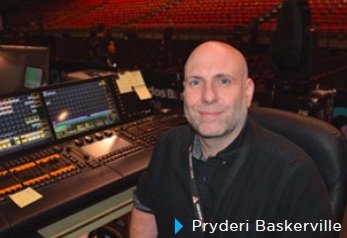 Lighting designer, director and programmer is Pryderi Baskerville who goes to great lengths to ensure his lighting fits the narrative of the show, never producing lighting for lighting’s sake. His lighting is fairly simple and never tries to compete with the massive visuals from both the video and projection content.
Lighting designer, director and programmer is Pryderi Baskerville who goes to great lengths to ensure his lighting fits the narrative of the show, never producing lighting for lighting’s sake. His lighting is fairly simple and never tries to compete with the massive visuals from both the video and projection content.
“The lighting system fits within the framework of the total show so it’s there to illuminate and enhance,” said Pryderi. “For the first half of the show, the screen is the visual dominant message and the lights are there to enhance that as well as follow Roger and pick out solos.
“If you’re expecting a big flash and trash lighting show, that’s not what this show is about. But hopefully it’s homogenous and sits within the entire narrative of the show.”
The lighting rig has a split FOH truss, two overhead trusses and two side tormentors and the workhorse fixture are the fifty-seven Robe BMFL Spots, currently Pryderi’s favourite spot fixture. Twelve are on the front truss, fourteen on the mid truss, fifteen on the upstage truss and the two tormentors house six a piece. On the floor are six Vari-Lite VL3500 Wash FX and normally on the side bunkers there are eight Robe BMFL Blades, although in Australia it was Martin MAC Viper Performances.
There’s a downstage trough for thirteen GLP X4 Bar20 which give the band a bit of a glow and also illuminate the children who come on for Brick Wall. They are also used for ‘accents’.
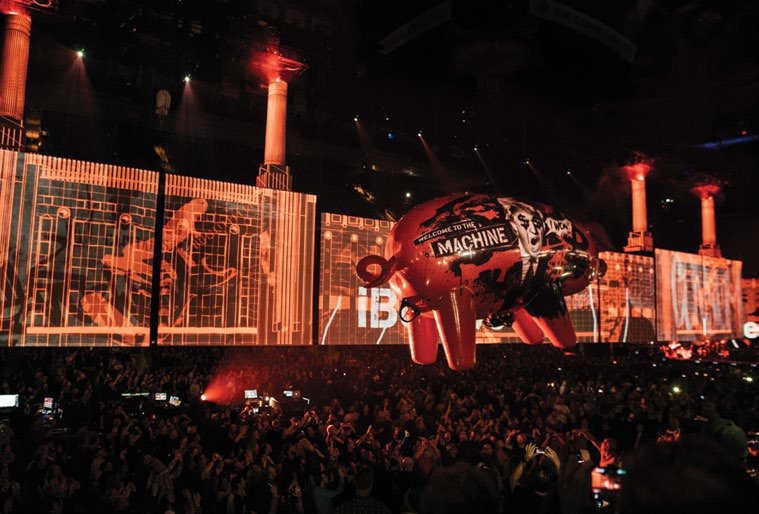
The two side trusses that extend into the audience not only hold the projectors for the split screen but also a large contingent of TMB Solaris Flares. Not a single house light needs to be switched on thus giving Pryderi control of the entire space. “It means we don’t have to rely on a venue having dimmable house lights,” explained Pryderi.
“The first cue of the show is a thirty second fade that draws you to the screen. I occasionally use the Solaris Flares for effects but primarily I’m using them as a wash source and they’re powerful, bright and have consistent colours. There are also eleven Solaris Flares acting as a large backlight wash on stage.”
Whilst two BMFL’s on the front truss are dedicated to following Roger with the infra-red technology, any of the lights in the rig can be assigned to that tracker.
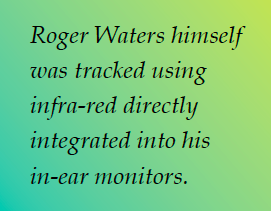 For example, 2 x BMFL are assigned as Tracking Backlights in ‘One Of These Days’; at the end of ‘Welcome To the Machine’, these are supplemented with Tracking Side Lights. With the two split projection screens flying in for the second half, there is no way a traditional follow spot would work.
For example, 2 x BMFL are assigned as Tracking Backlights in ‘One Of These Days’; at the end of ‘Welcome To the Machine’, these are supplemented with Tracking Side Lights. With the two split projection screens flying in for the second half, there is no way a traditional follow spot would work.
“We also didn’t want that massive 300ft beam of light coming from the back,” said Pryderi. “Out at FOH we have four BMFL Spots which follow the tracker in the pig when it flies around the arena. I have all control apart from movement with the positional data coming from the Albion. It’s the 21st century, why would you put people in the truss?”
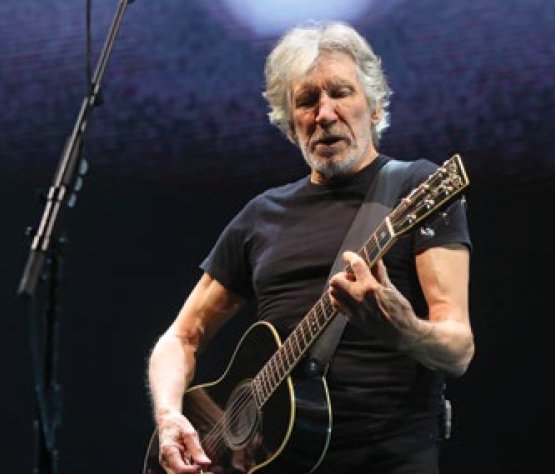 A lone Vari-lite VL6000 is rigged over the stage in a Tait winch with Lightlocks and it drops in for the helicopter effect at the beginning of Happiest Days. At FOH are two MA Lighting grandMA2, one for backup, with four NPU’s backstage and Pryderi travels with his own rack and processing.
A lone Vari-lite VL6000 is rigged over the stage in a Tait winch with Lightlocks and it drops in for the helicopter effect at the beginning of Happiest Days. At FOH are two MA Lighting grandMA2, one for backup, with four NPU’s backstage and Pryderi travels with his own rack and processing.
FOH AUDIO
Adelaide-based Jon Lemon took over FOH audio duties five shows into the tour when the legendary Trip Khalaf decided it was time to retire.
“I had just arrived home from London on a promo run with Lana Del Ray when Trip called me and after a brief 48 hour visit home, I was in Denver with Roger,” he remarked. “I’d worked with many of the production crew before, as well as Roger on the Pink Floyd reunion for Live 8, so it was a pretty easy transition.” Jon inherited Trip’s FOH set up which was all analogue including a couple of Midas XL4’s and a Yamaha PM5d for the surround sound.
“Everything else in the show is so high tech, it was nuts!” he said. “It’s such a theatrical show, I needed to have multiple scenes going on which you just can’t do in an analogue world, as good as it sounds. I lost several pounds running around like a madman trying to mix the show!”
Ten weeks into the tour there was a window of opportunity for Jon and his crew to go to Clair Global in Lititz and bring everything up to date. The PA was changed from a Clair i-5D system to the Clair Cohesion C0-12 system and control went digital with a DiGiCo SD5 plus Soundgrids.
“It was a massive change for me to do especially as Roger is as detail-orientated as I am pedantic,” said Jon. “I also had to do it without a band using only recordings, and then we only had one day of rehearsals before the next leg of the tour. It was a lot of pressure on me but fun at the same time.”
There are sixteen CO-12 deep in the main hang, twelve deep on the side hang, three flown subs facing forward (no cardioid) behind the main hang plus twelve subs on the ground. The indoor arena configuration is six CO-8 front fill.Delivering an immersive experience is a surround sound system of forty-eight Clair i-3 in custom built pods tailored to hang to suit the venue, but usually there are two pods per side right, rear and left.

Shure PSM1000 transmitted to UR Series receivers for the surrounds. After the Australian tour there’ll be more change with the Clair i3 surround sound system being replaced by the new Clair CO-10.
“It will be one of the first Cohesion CO-10 tours in the world,” commented Jon’s system tech and crew chief Dean Mizzi who was previously with JPJ Audio. “It’ll be all wirelessly fed from FOH by Shure wireless with full data and signal control from FOH. It’s all powered from the catwalk so there’ll be no cables from the sky.”
With the DiGiCo, Jon can snapshot scenes for various songs but he still wanted to keep an analogue feel to the mix hence a fair amount of analogue gear for the main left and right surround, as well as all of Roger’s different vocal mics.
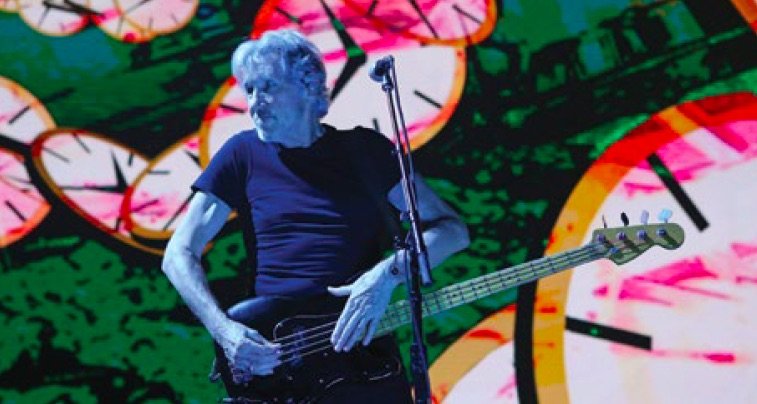
“I use Neve Shelford pre’s on Roger’s three vocal mics along with the plugin stuff I use for warmth and analogue emulation,” added Jon. “It looks quite over the top but it’s not really considering I have 110 inputs with ten people onstage.”
As to running the show, Jon says thank God for timecode! As the video content in the show is so heavy, he runs timecode from 8pm because there’s a lot of atmospheric material on the main screen as well as various sounds through the surround sound. At 8.20pm it’s show time.
“Again, one of the reasons I wanted it all running digitally was to be able to easily create multiple snapshots in songs,” said Jon. “However to get the most out of the show, it’s really manual so it’s nonstop concentration for me. It becomes a rhythmic thing, you just flow through it snapshot to snapshot. Roger listens to the show nearly every night and Sean also has input as he has a great ear.”
Jon changed a few microphones saying there’s nothing too flash being used; a few Shure ribbon mics on guitars, Telefunkens on guitars …. in fact there were heaps of guitar mics onstage. The drumkit was big with thirty inputs alone; Heil bass drum mics, Beyer snare drum mics, Neumann overheads, Audix and Sennheiser tom mics. JPJ Audio were the local provider.
MONITORS
In a cubby hole at side of stage sits monitor engineer Matt Napier, working from his DiGiCo SD7 console. He says his biggest challenge is trying to be faithful to the music whilst there are ten musicians on stage and just the one monitor engineer!
“It’s good now but rehearsals were quite stressful as you have ten people all trying to find their feet and it’s quite a large input count to have to deal with,” added Matt.
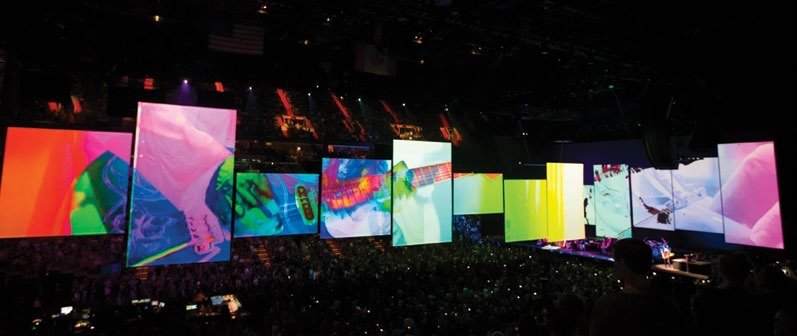
“Currently I have 130 inputs (many of which are stereo), 21 mono auxes, 16 stereo auxes, three mono groups, seven stereo groups, 32 matrix inputs, 14 matrix outputs, and 24 control groups.” Matt states that the DiGiCo SD7 is the only console that can cope with a gig of this size, in fact he only had five spare processing channels left on the console.
“I run the console at 48 as I don’t think you can hear the difference between 48 and 96 when you’re using IEMs because the weak link is the FM transmission,” he explained.
“FM only transmits from 50 hertz to 15K anyway so I don’t think you have to worry about being at 96K for a monitor console.”
Roger has an analogue vocal chain so his mic comes straight into an XL42 first and that has a distressor inserted over it – adds a little compression before it hits the A convertor on the console.
“I have a Lexicon 480 to give Roger’s vocal more warmth,” added Matt. “The reverbs on the console are good but the Lexicon 480 is fantastic, especially if you’re using IEMs. I also have a couple of Al Smart C2 compressors which are strapped over Roger’s mix; Roger is on the main master buss of the console and I pretty much mix him like a FOH mix.
“The C2’s catch things in the mix that maybe I don’t always catch and with a live dynamic band, if they get carried away they help keep it in the dynamic range that works with the IEMs.”
Everyone was using JH Roxanne IEMs with Sennheiser 2000 transmission systems plus there are a few discreet wedges onstage to add a bit of weight and extra stage volume for Another Brick In The Wall when the children’s choir take to the stage.
Most of the musicians are multi-instrumentalists, and also sing, so there is a lot of things going on for Matt; at the last count, he had about 70 different guitars in play. In addition to the musicians, there are a number of techs under the stage, and that is where the majority of the IEM mixes get eaten up.
RF is a massive challenge for Matt especially as the screen on stage is huge and production do not want to see the antennas. “Antennas work on line of sight so we had to get a little bit funky as to where we placed the antennas,” commented Matt.
Matt remarked that the SD Series sounds fantastic and he likes the flexibility of the SD Racks and SD-Mini Racks, the redundancy, and user flexibility.“I’m running lots of snapshots on the SD7 – over 75 – so I take timecode from playback and it’s all fired via timecode,” he said. “Most of that is smaller automation cues either from the musicians or its little rides, and by taking care of the constants I can then worry about the variables.”
Although the console is digital, the music strives for an analogue sound. Fortunately the SD7 has a warmth function that emulates the old Midas preamps from the XL4 and that softens the sound of the console. Matt further commented that he has a great audio stage crew with Richard Burke and Nicole Wakefield from Clair.
This article first appeared in the print edition of CX Magazine March 2018, pp.40-48. CX Magazine is Australia and New Zealand’s only publication dedicated to entertainment technology news and issues. Read all editions for free or search our archive www.cxnetwork.com.au
Photos: Troy Constable and Kate Izor. All text and photos © CX Media
More Floyd? Read CX’s coverage of the 2015 tour production here
Subscribe
Published monthly since 1991, our famous AV industry magazine is free for download or pay for print. Subscribers also receive CX News, our free weekly email with the latest industry news and jobs.


